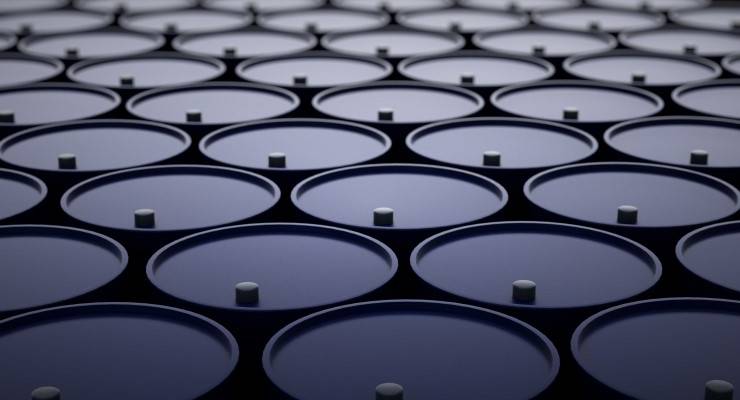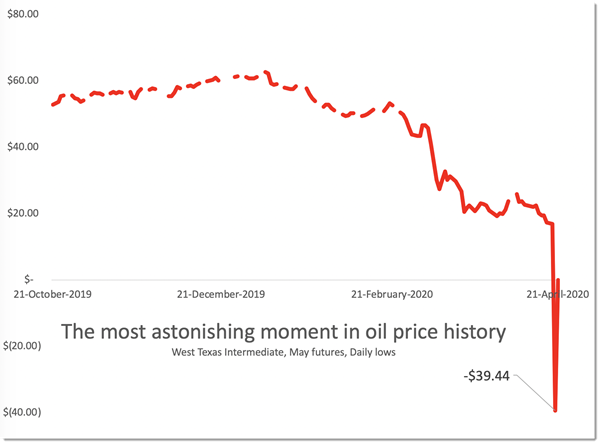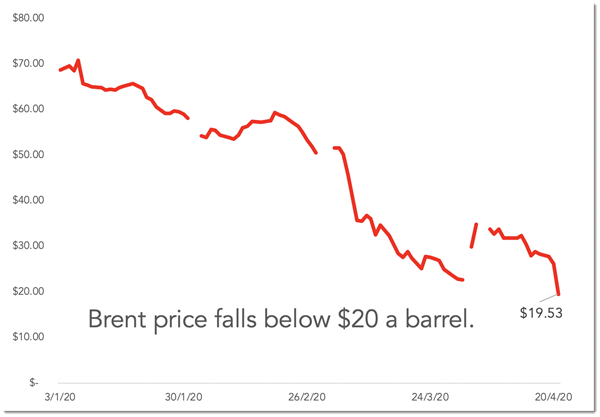
The price of a barrel of oil briefly turned negative on Tuesday, a historical first that will create economic and financial shockwaves.
The price of a barrel of West Texas Intermediate (a kind of crude oil) fell as low as negative-$39 a barrel. Sellers were paying buyers to take oil!

The negative price came about because huge volumes of oil are flowing in this period of low demand, and America is running out of places to put it.
The funny thing about oil futures — financial instruments which are the subject of enormous amounts of speculative investing activity — is that each month oil actually has to get delivered to the person who owns the contract.
For West Texas Intermediate, delivery happens in a small town in Oklahoma called Cushing. Cushing is a place with almost more oil tanks than it has houses. But the tanks are getting full, and anyone accepting delivery of oil in May is going to be stuck for options.

The oil price is not a single market price. It is therefore different to the price of a stock or the exchange rate. There are different prices for different oils, and the price is a “futures” price.
You buy oil to be delivered in May or June or July, etc. There are oil contracts traded for each month. Only the May price turned negative on Tuesday. June’s prices remained somewhat more normal, on the assumption that by the time oil has to be delivered in June, some sort of balance between supply and demand will be established.
On Tuesday, it appeared the great inversion was mostly a blip. A technical anomaly in the markets. But as Wednesday dawned, June prices have begun to sag dramatically, as the next graph shows. And the price fall is spilling out to other kinds of oil too.

The price of Brent oil has fallen sharply. That matters. Unlike West Texas Intermediate, which is a North American oil that they call “landlocked”, Brent is a widely-traded seaborne oil. (It is drilled in a very cold part of the world between the islands of Scotland and the fjords of Norway).
The Brent oil price is a benchmark — an input to a huge majority of other oil prices around the world.

Australia’s petrol price depends on a kind of oil called Malaysian tapis. But the price of tapis tracks the price of Brent oil very closely indeed.
So the impact from those full tanks in Cushing, Oklahoma, should soon be felt at your local petrol station. If filling up seems cheap now, just wait. Those receipts that offer a 4 cents per-litre discount could soon represent a genuinely substantial percentage discount.
For Australia, a lower petrol price would usually be very good news. Fuel is an input to many business, from agriculture to logistics.
And in much the same way that a lower interest rate leaves more money in mortgage-payers pockets and thereby boosts spending, so a lower petrol price leaves people with more disposable income and is stimulatory.
But of course, the current impact of lower prices is blunted. I’ve driven my car about four times in the last month. We’re saving on petrol not because it costs less but because we’re using less of it.
Instead, the major impact of lower oil prices will be to create a big blip in headline inflation. We are going to see deflation for the first time in many years. The RBA confirmed that it expected June quarter inflation result to be sufficiently below zero to create negative annual inflation.
Deflation could be quite unhelpful. It means your money buys more the longer you hold onto it, which discourages spending in the here and now. (This depressing effect of deflation is precisely why the RBA aims for low and predictable inflation.)
The Australian public is frightened enough. If deflation further discourages us from spending, our economic revival will be hobbled.
Of course, any slide in headline inflation needs to be looked at sceptically. The ABS measures the change in prices on a “basket of goods” and for the most recent period that basket of goods — containing restaurant meals, cinema tickets, automotive fuel, etc — will be completely different to what we actually bought (Netflix, grocery delivery, home heating).
Economically, the falling price of oil is terrible news for oil producers. But Australia is a net oil importer. Where we take a hit is on natural gas.
Gas exports have become one of the largest contributors to Australia’s export earnings, and to our GDP growth. We exported 80 million tonnes in 2019, more than any other country, and worth around $50 billion.
Gas and oil are in some applications substitutes. So lower oil prices drive down gas prices. Reports from before the most recent oil price wobble suggested gas export values could fall to $30 billion.
The shareprice of Woodside Petroleum — a gas producer — is down by nearly half since its peak in January this year. Santos Limited has fallen by more than half.
Those companies have also deferred many billions of dollars worth of development of new gas fields. That is bad news for the highly-paid engineering workforces that work in extraction, and also means the large refining operations the companies have spent so much money to develop could in future be underutilised.
A fall in the value of gas exports goes straight to our GDP. People are already bracing for a contraction of as much as 10%. Weak gas prices could make it even worse.
The implications of record low oil prices are going to be enormous.









For “blip” read “dip” in headline inflation?
Australia earns about $ 50 billion from gas exports as worlds No1 exporter.
Saudi Arabia earns about $ 150 billion from being the second largest exporter.
May God be praised.
Now if our government of, ” In the DNA economy managers”, could manage to bring our earnings up to Saudi levels. Ah! What a dream, all our plague “Debit and Deficit” solved, money for Hospitals, Schools, infrastructure and Pork Barreling.
The difference is accounted for mainly by the quality (or lack of it) of the slithering party apparatchiks the Australian entrusted with negotiating and setting the royalty levels.
Your gas comments are rubbish. WE get bloody near nothing for our gas. The profits do not attract significant tax and the royalties are non existent due to a holiday.
We give away our natural resources such as gas. Our actual earnings compared to sales are very low. Poor royalty and taxation policies to blame.
Knowing mother about this subject, but it seems to be a good time for Australia to be buying and stockpiling oil. Is this feasible?
It would be except that Australia has no excess storage capacity – in fact, not even enough normal capacity.
A series of uncaring liberal governments saw to that, and the oil industry (almost totally foreign owned) doesn’t give a damn about anything the amount of money it can ship home via tax evasion shelters.
Mother = nothing